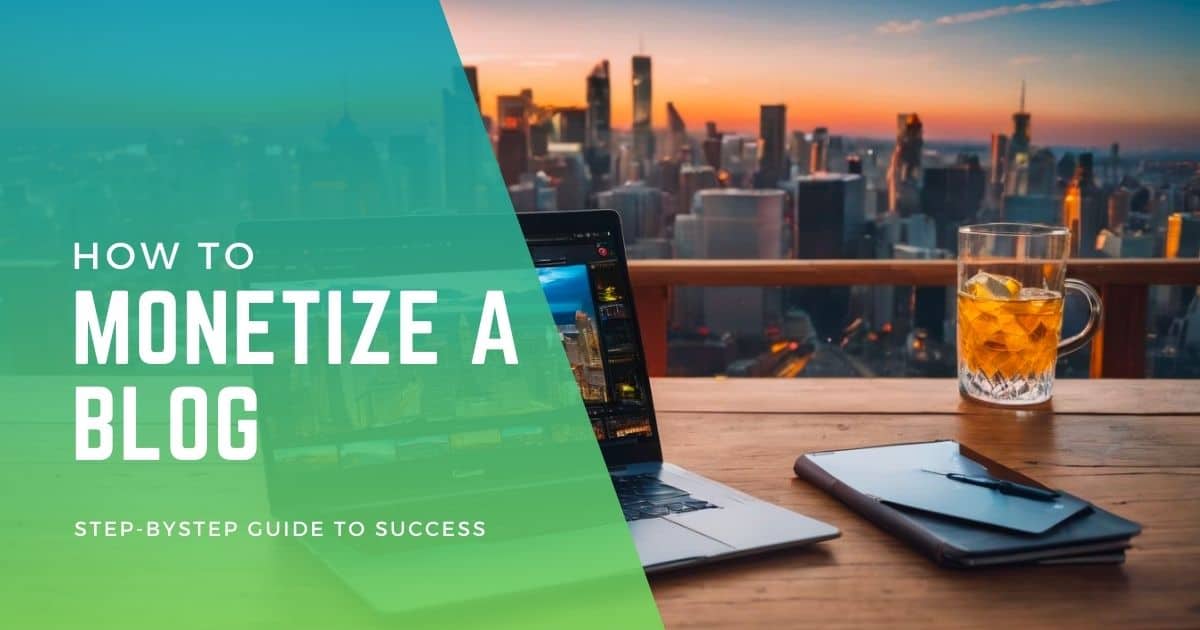Are you curious about how to make money blogging? You’re not alone. Many are searching for a way to turn their passion for writing into a lucrative side hustle. Essentially, making money through blogging means creating content that resonates with readers and strategically monetizing that content through various channels like advertising and affiliate marketing.
I know firsthand the challenges that come with this endeavor. It can be overwhelming, from finding the right niche to choosing the best monetization methods. But I’ve faced these challenges myself, turning them into opportunities for success. Rest assured, with the right guidance, you can overcome these obstacles and discover practical ways to profit from your blog.
Understanding how to make money blogging is essential for anyone looking to earn extra income online. This skill can open doors to financial freedom and flexibility. Stay with me, and we’ll go through the steps to turn your blog into a profitable venture.
Choose a Profitable Blog Niche

Selecting the right niche is crucial for attracting a target audience. To ensure your blog is profitable, consider the following:
- Research popular niches with high demand and low competition. Look for areas where people are actively seeking information or solutions but where there aren’t already numerous established blogs.
- Consider your interests, expertise, and market trends when choosing a niche. Find something you are passionate about and knowledgeable about, as this will make it easier for you to create valuable content that resonates with your audience.
- Look for a specific niche within your broader topic of interest. For example, if you’re interested in fitness, consider focusing on a specific area like yoga for beginners or healthy meal planning.
- Explore different options and brainstorm potential niches that align with your skills and interests. Think outside the box and consider unique angles or perspectives that could set your blog apart from others in the same space.
- Once you have identified potential niches, evaluate their profitability by considering potential revenue streams (e.g., affiliate marketing, sponsored content), audience size, and engagement levels.
Remember, choosing a profitable niche is just the first step towards making money blogging. It’s important to consistently create high-quality content that meets the needs of your target audience while leveraging various monetization strategies to maximize your earnings potential.
Step-by-step guide to setting up your blog

Register a domain name that reflects your brand or niche.
- Choose a memorable and relevant blog name that resonates with your target audience.
- Consider using keywords related to your niche to improve search engine optimization (SEO).
- Use domain registration platforms like GoDaddy or Namecheap to secure your chosen domain.
Choose a reliable web hosting provider for optimal website performance.
- Research different web hosting providers such as Bluehost, SiteGround, or HostGator.
- Compare their features, pricing plans, and customer reviews to find the best fit for your needs.
- Sign up with the chosen web host and follow their instructions to set up your account.
- Install WordPress through the web host’s control panel for easy website management.
Install a user-friendly content management system like WordPress.
- WordPress is widely recognized as one of the most popular and beginner-friendly CMS options.
- Follow the installation instructions provided by your web host or directly from WordPress.org.
- Customize your blog design by selecting themes and templates that align with your brand aesthetic.
- Add essential plugins for enhanced functionality, such as SEO optimization, social sharing buttons, or contact forms.
Publish your first blog post.
- Determine the focus of your blog content based on your niche or expertise.
- Conduct keyword research using tools like SEMrush or Keyword Chef to identify popular topics within your industry.
- Craft engaging and informative articles that provide value to readers.
- Incorporate visuals such as images or videos to enhance the visual appeal of your posts.
- Proofread and edit before hitting publish to ensure high-quality content.
Congratulations! You have successfully set up your new blog using WordPress as a starting point. Now, it’s time to focus on consistently creating valuable content while growing your site’s audience. Remember, blogging takes time and effort, but you can turn your blog into a profitable venture with dedication and perseverance.
Create compelling content for your audience

Understanding your target audience’s needs and preferences is crucial. By creating your winning content strategy and producing informative and engaging content regularly, you can establish yourself as an authority in your niche and attract a loyal following. Here are some key points to keep in mind:
- Know Your Audience: Take the time to research and understand your audience’s demographics, interests, and pain points. This will help you tailor your content specifically to their needs.
- Produce High-Quality Content: Focus on delivering valuable information that is well-researched, accurate, and up-to-date. Use your expertise to provide unique insights that set you apart from competitors.
- Variety of Formats: Cater to different audience preferences by utilizing various formats such as articles, videos, infographics, or podcasts. Some readers prefer written content, while others may prefer visual or audio-based formats.
- Consistency: Regularly publish new content to keep your audience engaged. Develop a content calendar or schedule to ensure a consistent flow of fresh material.
- Content Management System (CMS): Utilize a reliable CMS platform that allows easy organization and management of your content. This will streamline the publishing process and help you stay organized.
- Inspiration: Stay updated on industry trends, news, and discussions within your niche for inspiration on topics that resonate with your audience.
- Visual Appeal: Incorporate relevant images, graphics, or design elements into your content to enhance its visual appeal and make it more shareable on social media platforms.
Remember that creating compelling content requires both skill and effort. Continuously improve your writing skills and strive to meet the demands of your readers or clients by engagingly providing valuable information.
Following these guidelines, you can create high-quality content that captures your audience’s attention and helps you establish a successful blogging career.
Optimize your blog for search engines

Optimizing your blog for search engines is crucial to maximize your website traffic and attract more site visitors. Here are some key strategies to boost your search engine rankings:
- Conduct keyword research: Use a reliable keyword research tool to identify relevant keywords and phrases that align with your blog’s content. This will help you understand what users are searching for and enable you to incorporate these keywords naturally into your articles.
- Optimize meta tags, headings, URLs, and image alt text: Ensure each page on your blog has unique meta tags, including title tags and meta descriptions containing targeted keywords. Optimize headings (H1-H6) with relevant keywords, create SEO-friendly URLs, and use descriptive alt text for images.
- Improve website loading speed: Slow-loading websites can negatively impact user experience and SEO rankings. Optimize your blog by compressing images, minimizing CSS and JavaScript files, leveraging browser caching, and utilizing content delivery networks (CDNs) to enhance website loading speed.
- Enhance mobile responsiveness: With the increasing number of users accessing the internet via mobile devices, having a mobile-responsive blog is essential for better SEO rankings. Ensure your blog’s design adapts seamlessly across different screen sizes and resolutions.
By implementing these search engine optimization (SEO) techniques, such as conducting keyword research, optimizing meta tags and headings with targeted keywords, improving website loading speed, and enhancing mobile responsiveness, you can increase organic search visibility for your blog. Remember that optimizing your blog for search engines requires ongoing effort to stay ahead of changing algorithms and trends to attract more readership to your valuable content.
Build a strong brand for your blog’s success

To succeed in monetizing your blog, building a strong brand that resonates with your audience is crucial. Here are some key steps to consider:
Develop a unique brand identity through consistent visual elements like logo and color scheme.
Creating a personal brand for your blog is essential in distinguishing yourself from the competition. Think about the image you want to project and develop a unique visual identity that reflects your personality and niche. This can be achieved by consistently using logos, color schemes, and fonts.
Craft an authentic voice that resonates with your target audience.
Building a personal brand goes beyond just visual elements; it also involves creating an authentic voice that connects with your readers. Your writing style should reflect who you are and what you stand for. Consider the tone, language, and messaging that resonate most strongly with your target audience.
Promote your brand through guest posting on reputable websites or collaborating with influencers.
Once you have established your personal brand, it’s important to promote it effectively. One way to do this is by guest posting on reputable websites within your niche. This allows you to reach new audiences while establishing yourself as an expert in the field.
Another effective strategy is collaborating with influencers who align with your brand values. By partnering with influential individuals or brands, you can leverage their existing audience to increase your blog’s exposure.
Building credibility through thought leadership
Establishing yourself as a thought leader in your industry can greatly enhance the success of your blog’s brand. Share valuable insights, tips, and expertise through well-researched articles or educational content. This helps position you as an authority figure within your niche and builds trust among readers.
Remember, building a strong personal brand takes time and consistency. It requires careful consideration of visual elements, crafting an authentic voice, promoting through strategic partnerships, and establishing credibility through thought leadership.
Utilize social media for blog growth

- Increase visibility by creating profiles on popular social media platforms like Facebook, Twitter, and Instagram.
- Share valuable content regularly across social media channels to attract followers and drive traffic to your blog.
- Engage with the audience by responding to comments and messages promptly.
Creating a strong online presence is crucial for bloggers looking to profit from their blogs. One effective way to achieve this is by utilizing social media platforms. By following these strategies, you can leverage the power of social media to grow your blog and increase your chances of monetization.
- Create profiles on popular social media platforms: Establishing a presence on Facebook, Twitter, Instagram, and other relevant platforms allows you to reach a wider audience. It also helps build brand awareness and attract potential blog readers.
- Share valuable content regularly: Consistently posting high-quality content that resonates with your target audience is key. Share informative articles, engaging videos, captivating images, and other forms of content that align with your blog’s niche. This will attract followers and encourage them to visit your blog for more.
- Engage with your audience: Social media provides an opportunity for direct interaction with your readers. Responding promptly to comments and messages shows that you value their engagement. Encourage discussions around your posts, ask questions, and seek feedback from your followers. Building meaningful connections will help foster loyalty among your audience.
Remember that utilizing social media should be part of a broader strategy that includes other tactics, such as guest posting on relevant websites or creating a media kit for collaborations with brands.
Boost Blog Revenue with Affiliate Marketing

Ready to monetize your blog? Begin by joining affiliate programs that match your niche. Opt for reputable affiliate programs to ensure the relevance and quality of your recommended products or services. This strategic alignment enhances reader engagement and trust.
Earn commissions through affiliate links. Using unique links to track referrals after enrolling in an affiliate program. Commissions are earned when purchases are made through these links.
Maximize Conversions with Authentic Reviews
Writing honest product reviews is key to encouraging conversions. Share personal insights, including advantages and drawbacks, to build credibility and trust with your audience.
Expand your reach through social media by promoting your affiliate links on platforms like Instagram, Twitter, Facebook, and Pinterest. Engaging posts that highlight product benefits can significantly increase visibility and interest.
Consider additional monetization strategies, such as incorporating ad networks. Choose networks that provide relevant ads, balancing monetization with a positive reader experience.
- Diversify by joining multiple affiliate programs to enhance your income potential.
- Use analytics tools for tracking and optimization, focusing on click-through and conversion rates.
- Experiment with affiliate links and ad placements to find the optimal setup for your audience.
Building a monetized blog requires persistence and strategic effort. Continue to produce valuable content and refine your monetization tactics to meet the needs and interests of your readers.
With dedication and the right strategies, transforming your blog into a profitable platform is within reach. Stay tuned for more insights on enhancing your blog’s monetization potential.
Sell digital products on your blog

Creating and selling digital products on your blog is a great way to monetize your content and generate income. By offering valuable resources related to your niche, you can attract an audience willing to pay for the knowledge or tools you provide. Here are some key steps to get started:
- Create and sell e-books, online courses, or templates: Leverage your expertise by developing digital products that offer unique insights or solutions within your niche. Whether it’s an in-depth e-book, a comprehensive online course, or customizable templates, these offerings can provide value to your audience while generating revenue.
- Set up a secure payment system: To ensure seamless transactions and protect you and your customers, it’s crucial to set up a secure payment system on your blog. This lets visitors easily purchase digital products without concerns about compromised financial information.
- Promote through email marketing and social media: Once you have created and listed your digital products on your blog, promoting them effectively is important. Utilize email marketing campaigns to reach out directly to subscribers who have expressed interest in similar topics. Leverage the power of social media platforms by sharing enticing snippets of what customers can expect from purchasing your digital products.
Selling digital products on your blog provides an opportunity for passive income while delivering value to your readership. You can successfully monetize your blogging efforts by creating quality resources, setting up secure payment systems, and effectively promoting through email marketing and social media channels.
Remember: The key is understanding the needs of your audience within the niche you operate in and providing them with valuable solutions packaged as digital products.
So start brainstorming ideas today! What kind of e-books or online courses could you create that align with the interests of your readers? Let those creative juices flow as you explore this exciting avenue for making money through blogging.
Explore sponsored content and collaborations

- Collaborate with brands for sponsored posts or product reviews. Work with sponsors to create content promoting your blog’s products or services.
- Negotiate fair compensation based on your blog’s reach and engagement. Consider factors such as your audience size, engagement rate, and the value you provide to sponsors.
- Disclose sponsored content transparently to maintain trust with your audience. Clearly indicate when a post is sponsored or contains affiliate links to ensure transparency.
By exploring sponsored content and collaborations, bloggers can monetize their platforms while providing valuable content to their readers. Here are some ways to make money through sponsorships:
- Sponsored posts: Partner with brands and create dedicated blog posts that promote their products or services. These posts can include product reviews, tutorials, or personal experiences.
- Product reviews: Test and review products relevant to your niche. Brands may send you free products in exchange for an honest review on your blog.
- Exclusive content: Offer brands the opportunity to advertise exclusive content on your blog. This could be in the form of guest posts, interviews, or behind-the-scenes access.
- Partnerships: Establish long-term partnerships with brands that align with your blog’s values and target audience. These partnerships can involve ongoing collaboration for sponsored content creation.
- Ad space: Sell ad space on your blog to advertisers looking to reach your audience directly through banners, sidebar ads, or native advertising placements.
When engaging in sponsorships, it’s important to negotiate fair compensation based on the value you bring to the table:
- Determine your worth: Consider your monthly page views, social media following, email subscribers, and overall engagement metrics.
- Research industry rates: Look into what other bloggers in similar niches charge for sponsored content and use this information as a starting point for negotiations.
- Pitch confidently: Highlight your unique value to sponsors and explain how their brand will benefit from partnering with you.
- Be open to negotiation: Find a balance between fair compensation for your efforts and providing value to the sponsor.
Maintaining transparency is crucial in sponsored content:
- Disclose clearly: Indicate when a post is sponsored or contains affiliate links at the beginning or within the content.
- Be genuine: Only collaborate with brands that align with your blog’s niche and values, ensuring authenticity in your sponsored content.
- Educate your audience: Explain what sponsored content means and how it helps support your blog’s growth and continued free content creation.
By exploring sponsored content and collaborations, bloggers can create mutually beneficial partnerships with brands, monetize their blogs, and continue providing valuable content to their audience.
Diversify income streams as a blogger

As a blogger, it’s crucial to diversify your income streams to maximize your earnings. Here are different ways you can monetize your blog and create passive income:
- Display Advertising: Utilize platforms like Google AdSense to display ads on your blog. This allows you to earn money whenever visitors click on those ads.
- Freelance Services: Offer freelance services such as consulting, coaching, or writing for clients. Leverage your expertise and provide valuable services that align with your niche.
- Sell Physical Products: Set up an online store and sell physical products related to your blog’s niche. This could include merchandise, books, or other items that resonate with your audience.
By implementing these strategies, you can generate multiple income streams from your blogging efforts. Remember, the key is to diversify and explore various avenues for revenue generation.
Diversifying your income streams increases your earning potential and provides stability in case one source of income fluctuates. Take advantage of the opportunities you have as a blogger and leverage them smartly for financial success.
So start exploring the possibilities today and discover how to make money blogging through passive income and different ways!
Achieving financial success through blogging
Making money through blogging isn’t magic; it’s about being smart and persistent. Choose a good topic, set up your blog, and create content people love. Use social media, affiliate marketing, and maybe even sell your products. Remember, knowing how to make money blogging is a skill you can learn, and with time and effort, your blog can turn into a real business.
So why not start now? Your blog could be your next big thing that pays the bills. You’ve got the steps and the know-how, and all that’s left is to do it. It’s your time to shine!
Frequently Asked Questions
How much money can I make from blogging?
The amount of money you can make from blogging varies greatly depending on factors such as your audience size, niche, and monetization strategies. Some bloggers earn thousands of dollars per month, while others may only make a modest income.
How long does it take to start making money from blogging?
There is no set timeframe for when you’ll start making money from blogging. It depends on various factors, such as the time and effort you put into growing your blog, the quality of your content, and how effectively you monetize your platform. Generally, it takes several months to a year before bloggers start seeing significant income.
Do I need technical skills to set up a blog?
Setting up a blog does not require advanced technical skills. Many user-friendly platforms like WordPress make it easy for beginners to create their own websites without coding knowledge. However, having basic computer literacy and understanding online tools can be helpful.
Can I monetize my blog if I have a small audience?
You can still monetize your blog, even with a small audience. While having a larger audience may increase your earning potential, there are various ways to generate income through strategies like affiliate marketing, sponsored content, and selling digital products that don’t necessarily rely solely on high traffic numbers.
Is blogging a sustainable source of income?
Blogging can be a sustainable source of income if approached strategically and with persistence. You can create long-term financial stability as a blogger by consistently producing valuable content, growing your audience, diversifying income streams, and adapting to industry changes.



